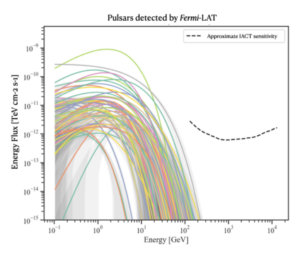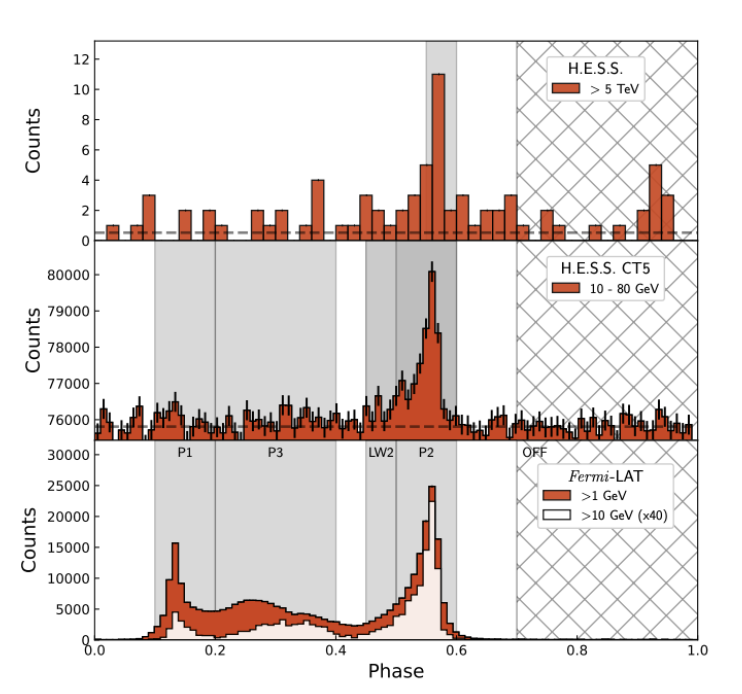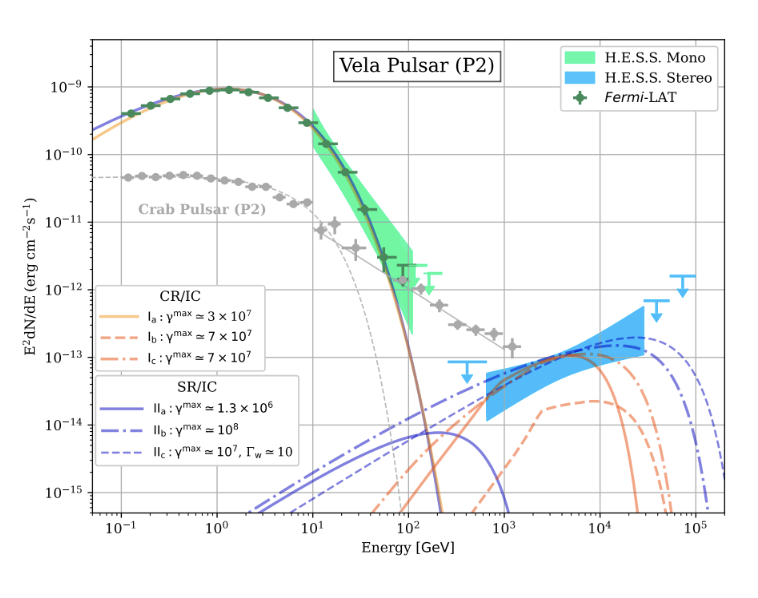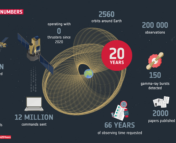Title: Discovery of a Radiation Component from the Vela Pulsar Reaching 20 Teraelectronvolts
Authors: H.E.S.S. Collaboration
First Author’s Institution: Dublin Institute for Advanced Studies, 31 Fitzwilliam Place, Dublin 2, Ireland
Status: Published in Nature [closed access]
Pulsars: the universe’s particle accelerators

Pulsars are rapidly rotating, highly magnetized neutron stars – the dense cores that remain after giant stars explode into supernovae at the end of their lives. Pulsars are often called cosmic lighthouses, since we observe regularly timed flashes of light as their beams sweep across our line of sight. Pulsars have strong magnetic fields that propel particles to super high speeds and energies, much like particle accelerators in laboratories. Electrons, protons, and other particles spiral along magnetic field lines and knock the photons they encounter up to really high energies (GeV – TeV). See Figure 1 for a rough scale of high energy wavelengths (which are often referred to by their energies). While pulsars are super cool examples of cosmic particle accelerators that are close-ish to home (most pulsars are “nearby” at hundreds to a few thousand parsecs from Earth), we don’t actually know where and how their light is produced, especially in the optical to very high energy (VHE) gamma-ray (what we usually call “high energy”) part of the electromagnetic spectrum.

Most observations of pulsars show a really abrupt cutoff of emission beyond gamma-rays of a few hundred GeV, where Fermi-LAT operates (see Figure 2). Despite lots of searching with ground based gamma-ray telescopes (called Imaging Atmospheric Cherenkov Telescopes or IACTs) whose energies are in the VHE range and extend beyond that of Fermi-LAT up to > 20 TeV, not much has been found. Back in 2011, the VERITAS IACT discovered VHE emission from the Crab pulsar, a pulsar that’s exceptionally bright at all wavelengths due to a lucky combination of it being close, young, and energetic. Discovering gamma-rays from a pulsar at such high energies seriously challenged the leading pulsar emission models at the time., as VHE gamma-rays were expected to get absorbed by their surroundings.
Today’s paper challenges pulsar models even further by uncovering a new gamma-ray emission component that’s never been seen before! Using High Energy Stereoscopic System (H.E.S.S.) observations of the Vela pulsar, the authors find that this new component extends from energies of ~5 TeV to over 20 TeV – which is almost double the highest energy of particles at the LHC particle accelerator!
The highest energy pulses we’ve ever seen [from a pulsar]

The authors make a phaseogram (see Figure 3) for Vela by averaging individual pulses to make a steady and smooth representation of what Vela’s “average” pulse should look like. In constructing this phaseogram, the authors kept increasing the energy threshold (i.e., only photons with higher energy than the threshold are used). To their surprise, they kept seeing a pulse! For other systems, like the Crab pulsar, there is a pulse beyond ~100 GeV, but it gets faint very quickly – even with hundreds of observation hours. Vela, on the other hand, shows a strong pulse up until the energy limit of H.E.S.S.’s sensitivity ~20 TeV with 80 hours of observations that have been taken since H.E.S.S. began observations in 2004.
A second spectral bump!
A key piece of information in astronomy is the spectrum of a source. Much like the spectrum of visible light you see by shining light through a prism, astronomical spectra show us the brightness of the light we see across all the observed wavelengths. Gamma-ray telescopes like H.E.S.S. are sensitive to gamma-rays at a variety of different wavelengths (or energies – shorter wavelength = higher energy) and can provide a lot of spectral information.

Today’s authors fit different pulsar emission models to their Vela pulsar spectrum (see Figure 4) to find that the spectrum has two bumps (like a [bactrian] camel) rather than the single high energy bump we see for every other pulsar (which looks more like a dromedary, a single bumped camel; see Figure 5). In the phaseogram, the authors note the alignment of the pulse peaks with those seen by Fermi-LAT, despite being two distinct spectral components. Generally, this means that both wavelengths are coming from the same population of accelerated particles, which can constrain where the VHE emission is coming from. This allows the authors to rule out emission regions where it’s impossible for photons at VHE energies to be produced.
Today’s authors suggest that this second bump originates from optical and infrared emission (which constitutes the first bump) from the pulsar being up-scattered by super energetic electrons accelerated in or around the pulsar. Current pulsar models can’t predict electrons of energies high enough to boost photons up to this second bump though. This is why the discovery in today’s paper poses some serious challenges for pulsar modellers even further than ever before.

Are other pulsars bumpy too?
Naturally, today’s paper prompts the question as to whether or not Vela is special with its two-bumped spectrum. Vela is one of the closest pulsars to the Earth at a distance of 287 parsecs and is the brightest pulsar at GeV gamma-ray energies, as seen by Fermi-LAT. Vela’s proximity and brightness are correlated in the sense that gamma-rays are easily absorbed by the interstellar medium – the gas, dust, and molecules that fill the voids between objects in the Milky Way (and other galaxies too), so the further the source, the fewer gamma-rays survive their journey to Earth.
The VHE gamma-rays that H.E.S.S. sees in today’s paper are both hard to produce and easy to absorb on their way to Earth, since absorption is especially high for short wavelength, high energy photons. This means that even if a second bump physically exists, it likely wouldn’t be bright enough for us to observe it with today’s gamma-ray telescopes.Today’s paper is an unexpected and exciting discovery for the pulsar and gamma-ray astronomy communities. Finding (or not finding!) other pulsars with second spectral bumps will be critical to understanding what’s going on with Vela and challenge our current understanding of how pulsars work. To help better understand how Vela fits in with the rest of the pulsar population, the authors suggest observing pulsars that are similar to Vela in distance and brightness with ultra high energy gamma-ray telescopes, such as LHAASO or with CTA, the next-generation IACT that will be able to detect dimmer sources at VHE energies.
Astrobite edited by Lina Kimmig
Featured image credit: Canva Science Photo Library



